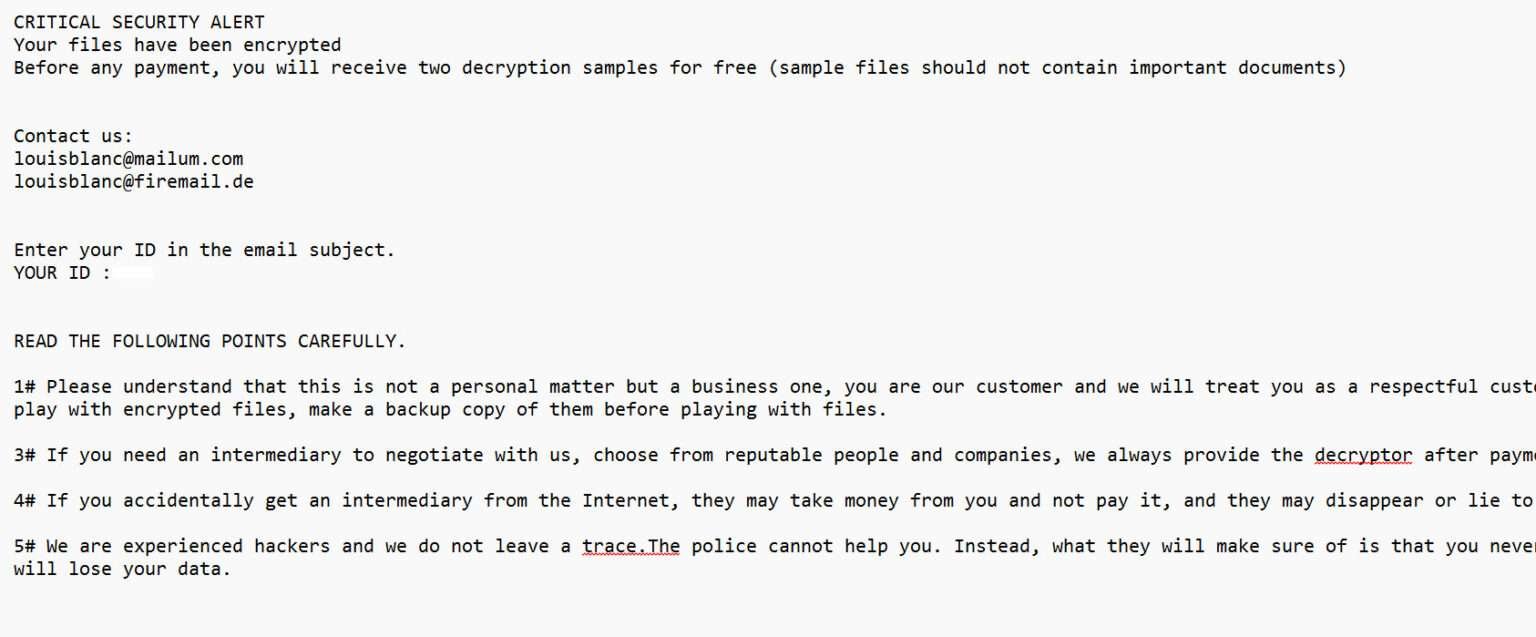 Blog's Page
Blog's Page

Louis Ransomware Is A Malicious Software Strain Designed To Encrypt Files On Infected Systems And Demand Payment For Their Decryption. First Detected In Mid-2021, It Typically Spreads Through Phishing Emails, Malicious Attachments, Or Cracked Software Downloads. Once Installed, Louis Ransomware Encrypts Files Using Strong Encryption Algorithms And Appends A Unique Extension To Affected Files, Rendering Them Inaccessible.
Victims Receive A Ransom Note Demanding Payment In Cryptocurrency In Exchange For A Decryption Key. The Note Often Threatens Permanent Data Loss Or Public Exposure If The Ransom Is Not Paid. Louis ransomware Can Disable Security Software And Delete System Backups To Prevent Recovery.
It Primarily Targets Windows Systems And Is Known For Affecting Both Individuals And Businesses. Experts Strongly Advise Against Paying The Ransom, As It Does Not Guarantee File Recovery And May Fund Further Criminal Activity. Instead, Victims Should Report The Incident And Attempt Recovery Using Professional Cybersecurity Tools And Backups.
A PC Can Be Compromised By Louis Ransomware Through Various Social Engineering And Exploitation Techniques. The Most Common Infection Method Is Phishing Emails Containing Malicious Attachments Or Links.
When A User Opens The Infected File—often Disguised As A Legitimate Document Or Executable—the Ransomware Silently Installs Itself. It May Also Spread Via Cracked Software, Malicious Ads, Or Exploit Kits That Target Unpatched Software Vulnerabilities.
Once Inside The System, Louis Ransomware Establishes Persistence, Disables Antivirus Tools, And Begins Encrypting Files Using A Strong Algorithm. It Appends A Unique Extension To The Encrypted Files And Drops A Ransom Note With Payment Instructions.
Some Variants May Also Delete System Restore Points And Backups To Prevent Recovery. The Ransomware Can Spread Laterally Across Networks If Administrative Privileges Are Gained. To Prevent Infection, Users Should Avoid Suspicious Links, Keep Software Updated, Use Strong Endpoint Protection, And Regularly Back Up Important Data Offline.
Louis Ransomware Primarily Targets Windows-based Systems And Affects A Wide Range Of Software And Applications By Encrypting Their Associated Data Files.
Commonly Impacted Software Includes
Microsoft Office (Word, Excel, PowerPoint),
Adobe Applications (Photoshop, Acrobat),
database Programs (MySQL, Microsoft SQL Server), And Productivity Tools Like
Notepad, Outlook, And Project Management Software. It Also Targets Files Used By Development Environments (e.g., .java, .py, .cpp Files) And Popular Cloud Storage Sync Folders. While The Ransomware Doesn’t Directly Compromise The Applications Themselves, It Encrypts Critical Files, Rendering Software Unusable. Networked Applications And File-sharing Services Are Especially Vulnerable To Lateral Spread And Data Encryption.
Preventing Louis Ransomware Involves A Combination Of Security Best Practices And Proactive Measures. Keep Your Operating System And All Software Updated To Patch Known Vulnerabilities. Use Reputable Antivirus And Anti-malware Solutions With Real-time Protection Enabled. Avoid Opening Suspicious Emails, Links, Or Attachments, Especially From Unknown Senders.
Disable Macros In Office Files And Block Executable Downloads Via Email. Implement Strong Passwords And Enable Multi-factor Authentication. Regularly Back Up Important Data To Offline Or Cloud Storage, And Test Your Backups. Limit User Privileges And Segment Networks To Reduce The Spread. Educate Users About Ransomware Risks And Safe Browsing Habits.
Removing Malware From A Windows Computer Involves A Combination Of Using Antivirus Or Anti-malware Tools, Performing System Scans, And Taking Manual Actions To Eliminate The Malicious Software. Here's A Step-by-step Guide:
Ctrl + Shift + Esc To Open Task Manager.Win + R To Open The Run Dialog, Type cleanmgr, And Press Enter.Remember To Maintain Good Security Practices, Such As Keeping Your Operating System And Software Up-to-date, Using A Reputable Antivirus Program, And Being Cautious When Clicking On Links Or Downloading Files From The Internet. Regularly Backing Up Your Important Data Is Also Crucial To Mitigate The Impact Of Potential Infections.
If You Have Malwarebytes Installed On Your Computer And It Has Detected Malware, Follow These Steps To Remove The Malware:
Open Malwarebytes:
Update Malwarebytes:
Run A Threat Scan:
Review Scan Results:
Quarantine Or Remove Threats:
Reboot Your Computer:
Check For Persistence:
Monitor For Issues:
Clear Browser Data:
Reset Browser Settings:
Review Installed Programs:
Change Passwords:
Update Operating System:









If The Malware Persists Or If You Encounter Difficulties During The Removal Process, You May Want To Seek Assistance From The Malwarebytes Support Community Or Consider Running Additional Scans Using Other Reputable Antivirus Or Anti-malware Tools. Remember To Keep Your Security Software Updated And Practice Safe Computing Habits To Minimize The Risk Of Future Infections.
Malwarebytes Is A Leading Cybersecurity Solution Dedicated To Protecting Users From The Ever-evolving Landscape Of Digital Threats. With A Proven Track Record In Malware Detection And Removal, Malwarebytes Offers Cutting-edge Technology To Safeguard Computers And Devices Against Viruses, Ransomware, And Other Malicious Software.
Boasting A User-friendly Interface, Malwarebytes Provides A Seamless Experience For Both Novice And Advanced Users. Its Real-time Protection Capabilities, Coupled With Powerful Scanning Algorithms, Ensure That Users Are Shielded From The Latest Cybersecurity Threats. Malwarebytes Continually Updates Its Extensive Malware Database, Enabling Users To Stay Ahead Of Emerging Risks And Vulnerabilities.
Beyond malware Detection, Malwarebytes Offers Additional Features Such As Web Protection And Anti-exploit Technology, Fortifying Defenses Against Malicious Websites And Zero-day Exploits. The Software's Lightweight Footprint Ensures Minimal Impact On System Performance, Delivering Robust Security Without Compromising Speed.
Whether Used As A Standalone Solution Or In Conjunction With Other Cybersecurity Tools, Malwarebytes Remains A Trusted Ally In The Battle Against Cyber Threats. As A Proactive And Responsive Cybersecurity Partner, Malwarebytes Empowers Users To Navigate The Digital World With Confidence, Knowing That Their Data And Devices Are Safeguarded Against The Latest And Most Sophisticated Threats.
Louis Ransomware, Louis Ransomware Removal, Remove Louis Ransomware, Uninstall Louis Ransomware, Delete Louis Ransomware, Get Rid Of Louis Ransomware